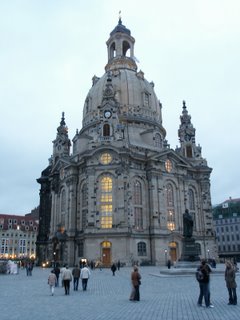 This is a short trip, so we do not have a lot of time for Dresden. We return to Berlin this evening. It is still icy chilly and we need gloves for comfort. Ron insists on making the most of the time, so we walk all over the city and take public transport when necessary.
This is a short trip, so we do not have a lot of time for Dresden. We return to Berlin this evening. It is still icy chilly and we need gloves for comfort. Ron insists on making the most of the time, so we walk all over the city and take public transport when necessary.
In spite of the bombing in WWII, there are still many highlights in this city. The Baroque Frauenkirche or Church of Our Lady is one of them. It is a Protestant sandstone church built in the 18th century, but was leveled during the war. A 12 year reconstruction project was undertaken at the cost of $160 million to bring it back to its original appearance. This was completed in October 2005. Architects and historians were able to piece together the original bricks that were still useable using archives and photos to put them in their original places. The church looks spotted as a result. The dark fire burned bricks stand out from the new replacement bricks surrounding them, giving the church a sense of resurrection or a phoenix rising from the ashes. Of the original stones, 8,425 were salvaged to be part of the reconstruction.
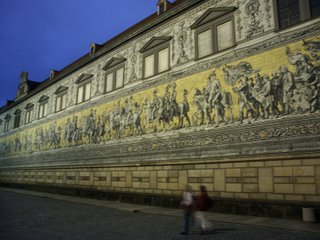
In the same area is a long wall with a 100-meter long porcelain mosaic called Fürstenzug. It is the ‘Procession of the Dukes’ displaying the rulers of Saxony. Nearby is the Semperoper opera house. It was built by Gottfried Semper, thus its name, in the mid-19th century. It is said to be one of Germany's finest examples of neo-renaissance architecture. Fire destroyed it in 1869 and again in 1945. The current building is an exact replica of the original.
The river Elbe runs through the city and divides it in two. We walked over the bridge a few times and enjoyed the views from both sides.
One of the most amazing sights for us was the Zwinger. This amazing complex was commissioned by Augustus II (the Strong), the elector of Saxony and king of Poland due to his passion for collecting paintings, sculpture, antiquities, but especially porcelain. His collection included 14,500 pieces of porcelain from China and Japan. He established the porcelain factory at Meissen in 1710. Augustus admitted his passion for porcelain was his maladie de porcelaine (porcelain sickness).
commissioned by Augustus II (the Strong), the elector of Saxony and king of Poland due to his passion for collecting paintings, sculpture, antiquities, but especially porcelain. His collection included 14,500 pieces of porcelain from China and Japan. He established the porcelain factory at Meissen in 1710. Augustus admitted his passion for porcelain was his maladie de porcelaine (porcelain sickness).
Augustus began to build the Zwinger in 1711. It resembles a palace and can easily be mistaken for one. The architect Matthaus Daniel Poppelmann designed it. The Zwinger was destroyed during World War II and partly reconstructed in 1952 and 1963. Now it is fully reconstructed and restored, displaying the famous porcelain collection.
This evening, we take the train back to Berlin.
Monday, June 05, 2006
Back to Dresden
0 comments
Posted by
Anonymous
at
9:44 AM
![]()
![]()
Labels: Berlin, Dresdner Frauenkirche, Germany, history, Meissen, Semperoper, Twentieth Century, World War II
Thursday, May 25, 2006
The Citadella
0 comments Ron and I wanted to see the photo exhibit at the Citadella, which Patricia and Don had talked about. It is a temporary exhibit called “Children of War”. Though they thought the photography was amazing, they felt horror at the subject matter.
Ron and I wanted to see the photo exhibit at the Citadella, which Patricia and Don had talked about. It is a temporary exhibit called “Children of War”. Though they thought the photography was amazing, they felt horror at the subject matter.
We took two buses to get there and then had to hike up the rest of the hill; only tour buses are allowed at the very top. It was a clear sunny day, making the fresh air jaunt more enjoyable then the time we went in the heat of August. There was a queue of tour buses waiting to park, alerting us that there would be plenty of tourists. The views of the city are breathtaking from up there, making it a popular place to visit.
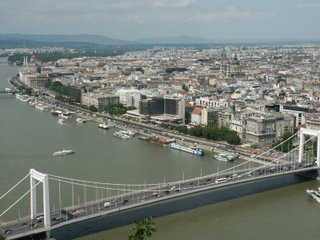
One can walk around quite freely and go to the lower vantage point under the statue of the lady with leaf in her hands, but to go higher and into the exhibit will cost you a bit of cash. According to the brochure given to us after shelling out 1,200 Huf each, we had these things in store for our viewing pleasure:
- An exhibit of military history with the artillery used by the Soviet army during their siege on Budapest
- A photo exhibit of Budapest from 1850-1945
- Waxworks and “Siege of Budapest, 1944” photo exhibit in the air-raid shelter from WWII
- Photo exhibit in the Hotel Citadella
- Memorial park showing the life of St. Gellért
- Exhibit of local history of Mount Gellért
Our first stop was the photo exhibit. It was in-depth, the photography was amazing and there were explanations in English. Since 1940, there have been 129 wars in the world and over 300 million children have died as a result. The photos covered numerous countries from five continents, not always grouped together. Many had some short explanation. The photos were hung on both sides of the walls in a hallway in the hotel that went in a circular fashion ending where one begins. Since I did not realize this, rather than bounce from side to side, I was going to view one side of the hall and then the opposite on my return to the entrance. When we found ourselves in the lobby yet again, Ron was too overwhelmed to join me for the other side. It was emotionally draining, so feeling I had seen enough, we just left for the next exhibit.
Walking toward the statue from the hotel and on the left was the local history exhibit of the Mount Gellért. Four store like display windows protect the exhibit from viewers sticky fingers. What is displayed is mostly geological information, nothing visually stimulating other than a few facts about the Celts and Romans who once occupied the area.
Next, we entered the bunker. This being the shelter and the wax museum, there were separate rooms to view from a hall only with wax representations of the ‘life’ during the war. If you are hawk or a historian, you could stay busy there for an hour or more. It took us fifteen minutes to walk through and take some photos.
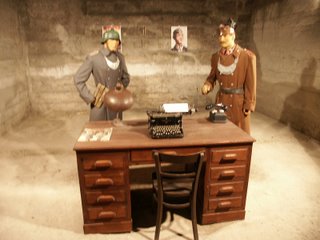
The “Memorial park” is a small rounded out area, which I suppose could semantically be called a park with the few flowers and shrubs in the overgrown planted area in the center. Again the history of St. Gellért is told in placards with pictures behind store front windows. Reading the explanations about the two folklore tales of his life, one being in the 1000s and the other placing him in the 1500s, there is not much to be impressed with.
If one were motivated, you could take a stairway down by the base of the statue for yet more store windows with still more displays that look as enthusiastically enticing as the rest. We decided to forsake this opportunity for more exercise. By now, Ron was getting anxious about being home in time for our guests; he took off for home and I continued on, merrily snapping pictures. The statue at the top looks just as impressive from the free viewing area, 15 feet below where I was standing, but shoot, I had paid to get in. I was going to get my money’s worth. The cityscapes were giving me chills of excitement. It was incredibly beautiful to see the whole city from here.
As I was leaving the area, I realized that what was meant by the Budapest 1850-1945 photo exhibit was in the free area. There are large billboard type photos with inserts showing various sights of the city in different years within the range stated. Was it worth the 1,200 Huf for the museums? Well, the photo exhibit was worth the 5 Euro charge, but this is a temporary exhibit. I would not pay it again unless there was another exceptional exhibit in the hotel. The view can be seen for free not that much farther down to make a difference.
Taking the back way down, I walked the trail to the Rudas thermals and took the bus to the Gellért Hotel for a picture. From there, I hopped on the 49 tram to the Great Market to wander around a bit. Realizing how often I recommend to guests that they get a langos in the market, I thought I had better do some quality assurance testing.
 For the uninitiated, a langos is the Hungarian version of fried dough, but with a difference. My favorite is with shredded cheese, ham, and garlic juice. When you go up the escalator to the second floor, there is a restaurant. By-pass this and follow the food stands along the one wall. At the end of the row of food stands is the only one that sells langos. The market being a tourist attraction, the langos stand has gone commercial with ‘Mexican’, ‘Italian’ and other nationality type langos toppings, but to be assured of a cultural experience, get the type that I get or one with sour cream and shredded cheese. They are delicious, but do not plan on eating again for four hours; they are filling.
For the uninitiated, a langos is the Hungarian version of fried dough, but with a difference. My favorite is with shredded cheese, ham, and garlic juice. When you go up the escalator to the second floor, there is a restaurant. By-pass this and follow the food stands along the one wall. At the end of the row of food stands is the only one that sells langos. The market being a tourist attraction, the langos stand has gone commercial with ‘Mexican’, ‘Italian’ and other nationality type langos toppings, but to be assured of a cultural experience, get the type that I get or one with sour cream and shredded cheese. They are delicious, but do not plan on eating again for four hours; they are filling. Pin It Now!
Posted by
Anonymous
at
2:48 PM
![]()
![]()
Labels: Budapest, English language, history, Hungary, Photography, Red Army, tourism, World War II
Friday, May 12, 2006
Off We Go
0 comments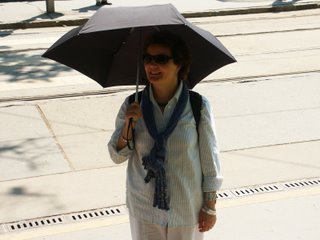 Off We Go…
Off We Go…
Don and Patricia flew into Vienna and will fly out of there also. Since Don is doing an article on traveling out of South Africa for 10,000 Rand per person, he was challenged to find the least expensive airline tickets possible. The best deal he could find was with Qatar Airlines from Cape Town to Vienna. They then took the airport bus from Vienna to Budapest and the subway from the bus station to our flat.
With this in mind, they made their first stop of the morning to the travel agency to purchase their bus tickets back to the Vienna Airport. About an hour later, I received a call from the travel agency stating they had forgotten to stamp the tickets with their agency stamp. Rubber stamps here are big business. Nothing is official if it does not have a stamp on it. They would need to return to have the tickets stamped.
Since they did not know this information about the stamps our lovely guests attempted to take the tour for the Parliament. Attempted is the key word, since they tried to get tickets for the 10:00 English tour, but the lines were so long, they could not. Instead, they headed across the street to the Ethnographic Museum.
This museum was started when it officially broke away from the National Museum in  1947. It finally found a permanent home in 1973 in what was the Palace of Justice building. The permanent exhibition "Folk Culture of the Hungarians" displays the everyday life and festivals of peasantry life of Hungarians within thirteen rooms. The collection ranges from objects collected from the end of the 18th century to World War II. http://www.neprajz.hu/english/index2.html
1947. It finally found a permanent home in 1973 in what was the Palace of Justice building. The permanent exhibition "Folk Culture of the Hungarians" displays the everyday life and festivals of peasantry life of Hungarians within thirteen rooms. The collection ranges from objects collected from the end of the 18th century to World War II. http://www.neprajz.hu/english/index2.html
Above all, Don was taken with the angst the bourgeoisie must have endured to climb socially upward from their conditions. He was particularly amused yet sympathetic to a photo on exhibit of a peasant wedding with the bride in her white dress, but yet wearing mud covered boots. Both he and Patricia were quite taken with the history of the country. Taking photos is acceptable and Don said he was not required to buy a photo ticket to do so.
We had arranged to meet for lunch, believing they would be finishing the Parliament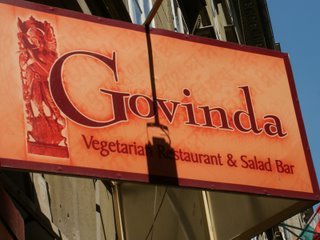 tour, but we did find them nonetheless. Since they both are
tour, but we did find them nonetheless. Since they both are  quasi-vegetarians, we took them to Govinda. This vegetarian restaurant is run by the Hare Krishna, who are well respected here. They do much for the homeless, so they are well supported. The food is great and inexpensive. Patricia and Don were overwhelmed with the quality and quantity of the servings so we received accolades for our choice of restaurant. Govinda is located at Belgrad rakpart 18, one stop on tram 2 from the Parliament. www.govinda.hu They accept cash only.
quasi-vegetarians, we took them to Govinda. This vegetarian restaurant is run by the Hare Krishna, who are well respected here. They do much for the homeless, so they are well supported. The food is great and inexpensive. Patricia and Don were overwhelmed with the quality and quantity of the servings so we received accolades for our choice of restaurant. Govinda is located at Belgrad rakpart 18, one stop on tram 2 from the Parliament. www.govinda.hu They accept cash only.
Our happy foursome then wandered over to Szabó Ervin Library. Why would any tourist want to see a library one may ask? If you do not have inside information, this may be a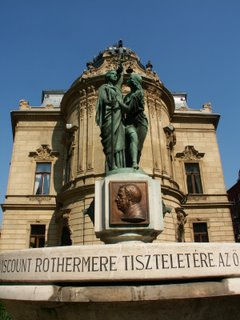 jewel that would easily pass-by without a visit. This is no ordinary library. It was once the Wenckheim Palace, a private residential palace, built by Count Frigyes Wenckheim (1842 – 1912). Arthur Meining, the architect from Saxony, built this 13,000 square meter building and is considered a masterpiece of Hungarian Neo-Baroque architecture. The building was turned into a library in 1931. Aside from the browsing area, there are 15 reading rooms, many with fireplaces and lush cushioned chairs, an Internet room, a playful children’s library with two huge dragons, 160 computers, seating for 1,000 readers, and a café. Various areas of it such as the ballroom are rented out for private functions.
jewel that would easily pass-by without a visit. This is no ordinary library. It was once the Wenckheim Palace, a private residential palace, built by Count Frigyes Wenckheim (1842 – 1912). Arthur Meining, the architect from Saxony, built this 13,000 square meter building and is considered a masterpiece of Hungarian Neo-Baroque architecture. The building was turned into a library in 1931. Aside from the browsing area, there are 15 reading rooms, many with fireplaces and lush cushioned chairs, an Internet room, a playful children’s library with two huge dragons, 160 computers, seating for 1,000 readers, and a café. Various areas of it such as the ballroom are rented out for private functions.
I chose to wait in the sunshine while Ron toured them around. To enter, you must get a free ‘Reader’s Card’ and you need a picture ID to get this. A passport is preferred, but a driver’s license will do most of the time. When Patricia came out our famous authoress was bowled over. She lovingly shared that the library rooms enchanted her with the mixture of glass, mirrors, gilt, drapery, carving, and books. “It was wonderful to see every seat filled with a young person immersed in a book. Reflecting on the fact that library budgets in South Africa have been slashed, I wonder if it will ever reach such a point as this…Poor Africa!"
Patricia wanting to purchase some ethnic music, we wandered around the corner to a shop situated in an udvar (garden) where there is also a lovely restaurant where we could stop for tea. We spent a relaxing hour in engaging conversation and then Ron took Patricia CD shopping while Don and I continued solving the world’s problems.
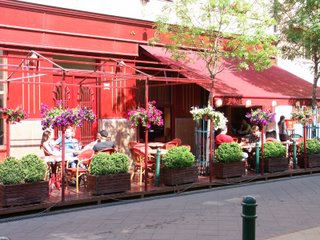 Ron offered to take their tickets back to the travel agency and I was going to escort them back to the Parliament to try to get the 6:00 pm tour, the last of the day. I love this tour and have done it six times, so I really did not want them to miss it. I prepped them that the first thing on the tour was a matchstick replica of the building that a Hungarian family created and donated.
Ron offered to take their tickets back to the travel agency and I was going to escort them back to the Parliament to try to get the 6:00 pm tour, the last of the day. I love this tour and have done it six times, so I really did not want them to miss it. I prepped them that the first thing on the tour was a matchstick replica of the building that a Hungarian family created and donated.
At the parliament, I left them for home and sent them on their way. When the tour guide asked the group if anyone could guess the materials of the replica, Don piped up with the correct answer squelching the bluster from the guide. Don thought it was a touch of irony that the building was inspired by the British, but it was the British who bombed them. Both Patricia and Don were impressed with King St. Stephan’s crown on display and found the crooked cross on top a bit curious. Don is never without his tripod and ultra deluxe professional camera, so was able to capture some magnificent shots.
The Hungarian Parliament is the largest Parliament in Europe, a testament to the fact that Hungary was an administrative center for the Austrian-Hungarian monarchy, the greatest power in Europe at one time. The architect Imre Steindl designed the building which was initially planned for the celebration of the millennium of 1896, but was not finished until 1902, the year of Steindl’s death. His inspiration was partly from the Palace of Westminster. Its white neo-gothic turrets and arches stretch for over 250 meters along the Danube embankment, making it an impressive sight from both sides of the river. The building has 691 rooms, tremendous halls and over 12.5 miles of corridors. The central dome is 96-meters, the exact height of Szent István Basilica. The saying is that this was intentional so that church and state were of equal proportions. Photograph and video are permitted and the inside is as rich as the exterior. The Parliament was once two houses: the House of Lords and the House of Commons. Don observed that the former House of Lords had blue carpeting and the House of Commons was red.
of Westminster. Its white neo-gothic turrets and arches stretch for over 250 meters along the Danube embankment, making it an impressive sight from both sides of the river. The building has 691 rooms, tremendous halls and over 12.5 miles of corridors. The central dome is 96-meters, the exact height of Szent István Basilica. The saying is that this was intentional so that church and state were of equal proportions. Photograph and video are permitted and the inside is as rich as the exterior. The Parliament was once two houses: the House of Lords and the House of Commons. Don observed that the former House of Lords had blue carpeting and the House of Commons was red.
Note that the official times on the Parliament website do not list this tour, but it is on the sign at the Parliament. http://www.parlament.hu/parl_en.htm
Tour times are listed as:
English: 10 a.m., 12 a.m. and 2 p.m.
German: weekday 11 a.m. and 3 p.m., Sunday 11 a.m.
French: 2 p.m. Russian: weekdays 3 p.m., Sunday 11 a.m.
Hebrew: 10.30 a.m. and 1.30 p.m.
Italian: weekdays 11.30 a.m. and 4 p.m., Sunday 11.30 a.m.
Spanish: weekdays 11.30 a.m. and 4 p.m., Sunday 11.30 a.m.
Japanese and other languages are available, but are not listed on the web site.
Tickets are: Adults 2.070 HUF and Children 1.035 HUF, but it is free for citizens of European Union countries if you have your passport with you.
After their tour, our two explorers walked the Danube. They came across the memorial of shoes along the river bank commemorating the Jews who were lined up on the banks and shot by the Nazis at the end of WWII when it was evident they had no time to continue transporting them to the camps. Sadly, there has been some vandalism and some of the shoes have been removed. Though the artist has vowed to replace them, it has not happened yet, but there are still enough there to impress the horrors of war on our social justice minded guests. Patricia is continually reminded of her Jewish heritage and the grievous events associated with Jewish history.
In later hours of the evening, they found their way to the docks to take a night cruise on the Danube. The hour long cruise was on the Duna Yacht and the cost was 1,700 Huf each. They were enchanted with the lighting in the castle district with Castle Hill romantically displayed on the one side of the river and with Parliament on the other. www.dunayacht.com
Posted by
Anonymous
at
11:49 PM
![]()
![]()
Labels: Africa, Cape Town, Hare Krishna, Patricia Schonstein, South Africa, tourism, Vienna, Vienna International Airport, World War II
![Reblog this post [with Zemanta]](http://img.zemanta.com/reblog_e.png?x-id=cafc5743-c630-458c-a297-057d31b0100e)
![Reblog this post [with Zemanta]](http://img.zemanta.com/reblog_e.png?x-id=062a043a-9a69-4024-b5ca-8890b147876c)
![Reblog this post [with Zemanta]](http://img.zemanta.com/reblog_e.png?x-id=76954298-f3ce-4848-8f64-f545ff59ea5d)













